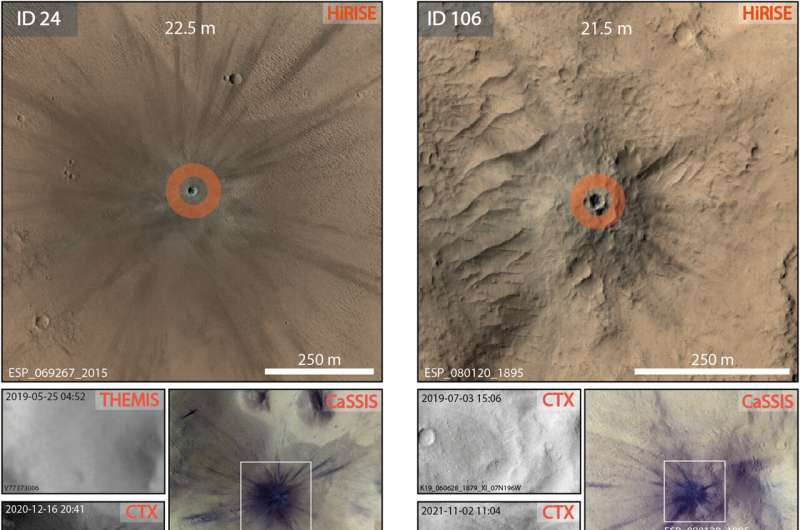Meteoroid impacts create seismic waves that cause Mars to shake more strongly and deeply than previously thought. This is shown by an investigation using artificial intelligence carried out by an international research team led by the University of Bern. Similarities were found between numerous meteoroid impacts on the surface of Mars and marsquakes recorded by NASA’s Mars lander InSight. These findings open up a new perspective on the impact rate and seismic dynamics of the red planet.
Meteoroid impacts have a significant influence on the landscape evolution of solid planetary bodies in our solar system, including Mars. By studying craters—the visible remnants of these impacts—important properties of the planet and its surface can be determined. Satellite images help to constrain the formation time of impact craters and thus provide valuable information on impact rates.
A recent study led by Dr. Valentin Bickel from the Center for Space and Habitability at the University of Bern presents the first comprehensive catalog of impacts on the Martian surface that took place near NASA’s Mars lander during the InSight mission between December 2018 and December 2022. Bickel is also an InSight science team member. The study has just been published in Geophysical Research Letters.
Machine learning identifies new Martian impacts
The impact events were cataloged using a machine learning approach. Tens of thousands of satellite images were searched for new craters that formed during the seismic monitoring by InSight. Using images from the High Resolution Imaging Science Experiment (HiRISE) and the Bernese Mars camera CaSSIS the craters were classified according to their size.
“Next, we compared the distribution of the craters with the seismic recordings from InSight and looked for matches in space and time,” explains first author Bickel. This innovative approach made it possible to identify a total of 123 previously unknown impacts. Based on their determined formation time, estimated magnitude and distance to InSight, the researchers found potential matches between 49 seismic events and one or more possible impact events.
“Our data show that more impacts occur on Mars than were determined in previous studies using orbital images,” says Bickel. The estimated impact rate is around 1.6 to 2.5 times higher than previously assumed. “Our observations show that some of the recorded marsquakes are actually caused by meteoroid impacts and not tectonic activity. This has far-reaching implications for estimates of the frequency of marsquakes and our understanding of the dynamics of the Martian surface in general.”
Wave propagation through the Martian mantle
In a companion study, the research team focused on one of the newly discovered events, a 21.5-meter impact crater in the Cerberus Fossae region, which the team linked to a specific high-frequency marsquake. The Cerberus Fossae rift system is located in a young volcanic plain on Mars that is known for its tectonic activity. This discovery enables the first direct comparison between an impact-induced seismic signal and a signal caused by internal tectonic movements.
The researchers compared the impact location and the time at which InSight registered the respective marsquake. They were able to show that some of the seismic waves propagated through the deeper Martian mantle and not, as previously assumed, only through the surface crust.
“These findings challenge previous assumptions about the propagation of seismic waves and suggest that numerous recorded marsquakes were actually further away from the Mars lander InSight than previously thought,” says Constantinos Charalambous, InSight science team member at Imperial College London and lead author of the companion study also published in Geophysical Research Letters.
“In addition to re-locating the epicenters of a range of quakes, this also means that the internal structural model of Mars needs to be revised,” says Charalambous.
Searching for further similarities
“Our results are not only important for the scientific community. For example, if you want to build a permanent infrastructure on Mars in the future, you need to be able to assess the risk of structural damage, such as caused by meteoroid impacts,” emphasizes Bickel.
The studies show that the combination of seismic data and orbital image information is crucial for understanding the geophysical properties of Mars. Further research on Mars will aim to refine estimates of marsquake frequency and impact rates.
The studies are the result of an international, interdisciplinary collaboration between researchers from the University of Bern and other renowned institutions, including the NASA Jet Propulsion Laboratory (JPL), Imperial College London, Brown University, and ETH Zurich.
“At the University of Bern, we are ideally positioned to conduct this type of research—particularly because of our interdisciplinary expertise in planetary sciences and machine learning, as well as Bern’s active participation in InSight, HiRISE and CaSSIS,” concludes Bickel.
More information:
V. T. Bickel et al, New Impacts on Mars: Systematic Identification and Association With InSight Seismic Events, Geophysical Research Letters (2025). DOI: 10.1029/2024GL109133
Constantinos Charalambous et al, New Impacts on Mars: Unraveling Seismic Propagation Paths Through a Cerberus Fossae Impact Detection, Geophysical Research Letters (2025). DOI: 10.1029/2024GL110159
Provided by
University of Bern
Citation:
Machine learning reveals meteoroid impacts may play a bigger role in triggering marsquakes (2025, February 3)
retrieved 3 February 2025
from https://phys.org/news/2025-02-machine-reveals-meteoroid-impacts-play.html
This document is subject to copyright. Apart from any fair dealing for the purpose of private study or research, no
part may be reproduced without the written permission. The content is provided for information purposes only.

